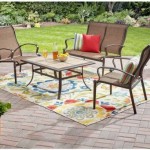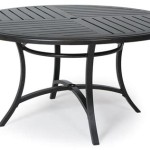Essential Aspects of DIY Patio Furniture Plans
Creating your own custom patio furniture can be a rewarding and budget-friendly project. With careful planning and the right materials, you can enjoy a comfortable and stylish outdoor space for years to come. Here are some essential aspects to consider when crafting your own DIY patio furniture plans.
1. Material Selection
The choice of material for your patio furniture will significantly impact its durability and aesthetics. Consider the following options:
* Pressure-Treated Wood: Durable and economical, pressure-treated wood is an ideal choice for outdoor furniture. It is resistant to rot and insects. * Cedar: A naturally rot-resistant wood, cedar has a beautiful reddish-brown color. It is more expensive than pressure-treated wood but offers superior durability. * Redwood: Known for its exceptional resistance to rot, redwood is a top choice for outdoor furniture. However, it can be more costly than other options. * Teak: A tropical hardwood, teak is highly water-resistant and durable. It develops a distinctive silver-gray patina over time. * Plastic: A weather-resistant and low-maintenance option, plastic furniture is available in various colors and styles.2. Design Considerations
When designing your patio furniture, consider the following factors:
* Comfort: Ensure your furniture provides ample support and cushioning. Use ergonomic principles to maximize comfort. * Durability: Choose materials that can withstand outdoor elements, such as sun, rain, and wind. Consider adding protective finishes to enhance longevity. * Style: Match the furniture to the décor of your patio and home. Consider the overall aesthetic and color scheme. * Functionality: Determine the purpose of your furniture and design it accordingly. Consider storage options, foldable designs, or adjustable features.3. Tools and Materials
Before starting your project, gather the necessary tools and materials. Essential tools include a saw, drill, screwdriver, clamps, and measuring tape. Other materials may include:
* Wood or other construction materials * Cushions and upholstery (optional) * Hardware (screws, bolts, nuts, etc.) * Protective finishes (stain, sealant, paint)4. Step-by-Step Instructions
Once you have gathered your materials and tools, follow clear and detailed step-by-step instructions. These instructions should include:
* A list of materials and tools needed * Precise measurements and cut lists * Assembly instructions with clear diagrams * Finishing instructions5. Safety Precautions
Always prioritize safety when working with tools and materials:
* Wear appropriate safety gear (gloves, safety glasses, etc.) * Use power tools cautiously and follow manufacturer's instructions * Work in a well-ventilated area6. Troubleshooting Common Issues
Be prepared to encounter minor issues during your project. Some common problems include:
* Uneven cuts: Use a sharp saw and measure carefully * Loose joints: Tighten screws and hardware securely * Rust or decay: Choose materials that are resistant to weather * Misaligned pieces: Refer to your instructions and make adjustments as needed7. Finishing Touches
Complete your patio furniture with the following finishing touches:
* Add cushions or upholstery for comfort * Apply a protective finish to enhance durability and aesthetics * Arrange your furniture to create a cohesive and inviting outdoor space
Diy Patio Chair Plans And Tutorial Step By S Photos
:max_bytes(150000):strip_icc()/homemadebycarmona-386463f43539452b8b033a4108701959.jpg?strip=all)
23 Diy Patio Furniture Plans

37 Amazing Diy Outdoor Furniture Plans The Handyman S Daughter

Diy Outdoor Furniture Plans Patio

Top 10 Most Popular Diy Outdoor Furniture Plans The Design Confidential

Diy Outdoor Furniture 10 Easy Projects Bob Vila

Diy Outdoor Patio Chairs The Inspired Work

Diy Patio Chair Plans And Tutorial Step By S Photos

Modern 2x4 Outdoor Sofa Plans Fix This Build That

Diy Modern Outdoor Sofa Plans 731 Woodworks
See Also








